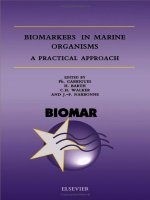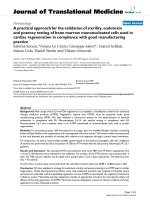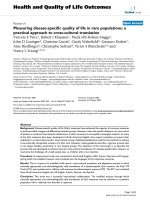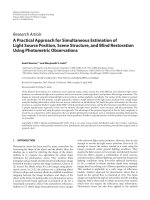Biomarkers in marine organisms a practical approach
Bạn đang xem bản rút gọn của tài liệu. Xem và tải ngay bản đầy đủ của tài liệu tại đây (30.52 MB, 551 trang )
Preface
Over the last decades, the concept of biomarkers has had a major impact upon
environmental sciences. The term is related to biological changes that may be
observed in organisms under environmental stresses that are either natural or
environmental. It refers to different kinds of biological parameters in
biochemistry, physiology, histology and at various organisation levels such as
molecular, cellular, organism, population community or ecosystem levels.
Many previous studies and books have been dedicated to fundamental and
developmental aspects of biomarkers. The purpose of this book is to provide,
through various case studies, an overview of the practical use of biological
markers in marine animals to evaluate the health effects of environmental
contamination in marine ecosystems. More precisely, the book presents the
results obtained during the development and application of biological markers as
indicators of exposure/effect to toxic chemicals in marine environments, using
diverse sentinel species such as fish, bivalves and crustaceans. An important
aspect is also the publication of technical annexes that describe, in detail, the
experimental procedures developed for both chemical and biochemical
measurement.
The book is intended to be of interest to a wide range of readers. For
environmental chemists and toxicologists, the book provides a pragmatic
approach to both, the use of biomarkers in the marine field and, the
implementation of a biomarker-based monitoring program. More generally,
scientists in governmental agencies who have responsibilities at both the national
and international level, will fred the results of biomarker studies and also a
comprehensive technical annex to set up these methodologies.
The editors wish to acknowledge and thank the European Union who provide
funds to develop research programmes on biomarkers in the marine environment.
These works have been conducted through two main research projects titled:
'Evaluation of harmfifl effects of environmental contamination in marine
ecosystems using biomarkers (EV5V-CT94-0398)' and 'Biological markers of
environmental contamination in marine ecosystems' the so-called BIOMAR
Project (EV5V-CT94-0550 and ENV4-CT96-0300. The editors and the authors
would like to thank the experts who have peer-reviewed the chapter and also
Corinne Rivereau, University of Bordeaux I, for the editorial work in preparing
this book.
Philippe Garrigues
University of Bordeaux I
June 2001
List of participants of European Projects
Contract EV5V-CT94-0398 : Evaluation of harmful effects of pollutants in
marine ecosystems using biomarkers
Prof. C. WALKER (coordinator), Cissbury, Hillhead, Colyton, Devon EX24
7NJ, United Kingdom
Dr D. SAVVA, Division of Cell and Molecular Biology, School of Animal and
Microbial Sciences, The University of Reading, Whiteknights PO Box 228,
Reading RG6 6AJ, United Kingdom
Email 9
Dr
M. DEPLEDGE, Dr S. BAMBER,
Plymouth Environmental Research
Cemre, Departmem of Biological Sciences, University of Plymouth, Drake
Circus, Plymouth PL4 8AA, United Kingdom
Email "
Dr C. FOSSI, Dr S. CASINI, Departmem of Environmental Biology,
University of Siena, Via delle Cerchia 3, 53100 Siena, Italy
Contract E V5 V-CT940550 : Biological
contamination in marine ecosystems
markers of
environmental
Dr. Ph. GARRIGUES (Coordinator), Environmental and Toxicological
Chemistry, UMR 5472 CNRS, University of Bordeaux I, 351 Cours de la
Lib6ration, 33405 Talence Cedex France
Email 9
Dr. H. BUDZINSKI, Dr. JF NARBONNE, Environmental and Toxicological
Chemistry, UMR 5472 CNRS, University of Bordeaux I, 351 Cours de la
Lib6ration, 33405 Talence Cedex France
Email : fr
Dr. F. GALGANI, Dr. T. BURGEOT, IFREMER, Centre de Nantes, Rue de
l'Ile d'Yeu, 44037 Nantes Cedex 01 France
Email 9 tburgeot@ifremer, fr
Dr. P. VENIER, Universita Degli Studi di Padova, Dipartimento di Biologica,
Via Bassi 58/B, 35121 Padova Italy
Email 9
Dr. M. LAFAURIE, Dr. M. ROMEO, Toxicologie Marine, Facult6 de
M6decine, Avenue Vallombrose, 06107 Nice, Cedex 02 France
Email "
Prof. P. DESCHAUX, Laboratoire d'Immunophysiologie, 123 Avenue Albert
Thomas, 87060 Limoges Cedex, France
Dr. JP. SALAON, Station biologique de Roscoff, Laboratoire de Biologie
Cellulaire et Mol6culaire des Macroalgues, 29682 Roscoff Cedex France
Dr. P. DEN BESTEN, Institute for Inland Water Management, P.O. Box 17,
8200 AA Lelystad, The Netherlands
Email 9
Dr. J. POSTMA, AquaSense Laboratory, P.O. Box 95125, 1090 HC,
Amsterdam, The Netherlands
Dr. G. PAGANO, Istituto Nazionale per lo Studio e la Cura, Via M. Semmola
12, Napoli 80131, Italy
Email 9
Dr. C. PORTE, Dr. MONTSERRAT SOLE, CSIC-CID, Departament de
Quimica Ambiental, Jordi Girona 18, 08034, Barcelona Spain
Email 9
Dr. D. LIVINGSTONE, Dr. L. PETERS, Plymouth Marine Laboratory,
Citadel Hill, Plymouth PL 1 2PB United Kingdom
Email 9
Prof. Dr. PD HANSEN, Dr H. DIZER, Institut Ftk Okologie, Technische
Universi~t Berlin, Keplerstrasse 4-6., 10589 Berlin Germany
Email 9
Dr. C. BOLOGNESI, Dr. P. DEGAN, Prof. A. VIARENGO, Toxicological
Evaluation Unit, National Institute for Cancer Research, L.go Rosanna Benzi 10,
16132 Genova Italy
Email :
Abbreviations
2,4D
2-PAM
3MC
4CL
AChE
AEC
AH
BaP
BaPMO
BChE
BPH
BPH
BPO
BSAF
CA4H
CAT
CbE
ChE
CYP
CYP
d.w.
DEHP
DRZ
ECD
ECOD
ELS
EROD
FCS
FITC
FMO
GC-MS
GSH
GST
GVBD
HCH
2,4 Dichlorophenoxy
Pyridine 2-aldoxime methiodide
3-MethylCholanthrene
4-cotmaarate:CoAligase
Acetylcholinesterase
Adenyle Energy Charge
Aromatic hydrocarbons
Benzo(a)pyrene
Benzo(a)pyrene Monooxygenase
Butyrylcholinesterase
Benzo(a)pyrenehydroxylase
Benzo(a)pyrene hydroxylase
Benzo(a)pyrene Oxydase
Biota Sediment Accumulation Factor
Cinnamic Acid 4-hydroxylase
Catalase
Carboxylesterase
Cholinesterase
Cytochrome, mRNA = RisoNucleic Acid
Cytochrome
Dry weight
Di(2-ethylhexyl)phtalate
Diagonal radioactive zone
Electron Capture Detection
Ethoxycoumarin-O-deethylase
Embryonic Development Test
Eth~176
Foetal Calf Sertan
Fluorescent Isothiocyanate
Flavin-containing monooxygenases
Gas Chromatography/Mass Spectrometry
Reduced glutathione
G lutathione- S-transferase
Germinal Vesicle Breakdown
Hexachloroeyclohexane
ICP Inductively Coupled Plasma
iso-OMPA Teraisopropyl pyrophosphoramide
LOD Limit of Detection
LOEC
LOQ
MDA
MFO
MO
MPI
MT
NOEC
OP
PAH
PAH
PAL
PCB
PCP
RAL
RNO
ROS
RT-PCR
TBT
TCDD
TIE
TLC
W.W.
Lowest Observed Effect Concentration
Limit of Quantitation
Malonedialdehyde
Mixed Function Oxygenase
Monooxygenase
Multimarker Pollution Index
Metallothionein
No Observed Effect Concentration
Organophosphorus pesticides
Polycyclic Aromatic Hydrocarbons
Polycyclic Aromatic Hydrocarbons
Phenylalanine Ammonia Lyase
Polychlorobiphenyls
Pentachlorophenol
Relative adduct labelling, expressed as adducts per 10 8 nucleotides
R6seau National d'Observation
Reactive Oxygen Species
Reverse Transcription-Polymerase Chain Reaction
Tributyltin
TetraChloroDibenzoDioxine
Toxicity Identification Evaluation
Thin layer chromatography
wet weight
Biomarkers in Marine Organisms: A Practical Approach.
Ph. Garrigues, H. Barth, C.H. Walker and J.F. Narbonne, editors.
9 2001 Elsevier Science B.V. All rights reserved.
Chapter 1
INDUCTION OF MOLLUSCAN CYTOCHROME
P450
MONOOXYGENASE SYSTEM AS A BIOMARKER OF ORGANIC
POLLUTION IN ENVIRONMENTAL MONITORING
L. D. Peters* and D. R. Livingstone
CCMS Plymouth Marine Laboratory, Citadel Hill, Plymouth, Devon, PL1 2PB,
United Kingdom
Abstract
The characteristics of the properties and regulation of molluscan (bivalve,
gastropod, cephalopod, chiton) cytochrome P450 monooxygenase system will be
described, including enzymological, antibody-recognition and molecular biological
information on multiple forms of cytochrome P450 (CYP1A, CYP2B, CYP2E,
CYP3A, CYP4A, CYP10, CYP11A). The evidence for the presence of an
inducible CYP1A-like enzyme will be discussed. Field data on the application of
the cytochrome P450 monooxygenase system and a CYP1A-like enzyme as
biomarkers of organic pollution will be presented for an oil spill ("Aegean Sea"
incident off Spain), long-term industrial pollution (Venice Lagoon, Italy) and
transplant studies (Skagerrak, North Sea).
Keywords: Mytilus,
CYP1A, CYP2B, CYP2E, CYP3A, CYP4A, benzo[a]pyrene
hydroxylase, oil spill, Venice lagoon, North Sea
2
1. THE UPTAKE OF XENOBIOTICS AND BIOACCUMULATION IN
AQUATIC MOLLUSCS
The phylum Mollusca consists of 8 classes; Chaetodermomorpha,
Neomeniomorpha, Monoplacophora, Polyplacophora, Scaphopoda, Cephalopoda,
Gastropoda and Bivalvia however the latter two classes contain 98% of the known
molluscan species (Barnes
et al.,
1988). The uptake and subsequent
bioaccumulation of anthropogenic xenobiotics from the aquatic environment has
been examined in numerous freshwater and marine molluscan species (Doyotte
et
al.,
1997; Livingstone 1991, 1992, 1994; O' Connor 1996).
Comaminants including polycyclic aromatic hydrocarbons (PAHs) (Baumard
et al.,
1998; Krishnakumar
et al.,
1997; N~es
et al.,
1998), polychlorobiphenyls (PCBs)
(Krishnakumar
et al.,
1997; Livingstone
et al.,
1997; O'Connor, 1996),
organophosphates (Dauberschmidt
et al.,
1997; McHenery
et al.,
1997),
organometals (Morcillo
et al.,
1997; Page
et al.,
1995), thiocarbamates (Doyotte
et
al.,
1997) and metals (Doyotte
et al.,
1997; Viarengo
et al.,
1997; Walsh &
O'Halloran, 1998) are biologically available to molluscs and uptake is proposed to
occur from the sediment, suspended particulate matter, water-column and food
sources (Livingstone 1991, 1992; Krishnakumar
et al.,
1997)
The major routes of uptake of these contaminants will depend upon the dietary and
ecological lifestyle of the particular organism however the processes of uptake of
the organic contaminants are largely passive determined by physico-chemical
principles viz. molluscan tissue body burden increases with increased external
concentration, bioavailability and lipophilicity of the xenobiotic (Livingstone &
Goldfarb, 1998). Due to the apparent low rates of biotransformation of the
contaminants to polar metabolites, the resultant slow elimination of xenobiotics from
molluscan tissue leads to the bioaccumulation of contaminants (Livingstone 1994)
and thus filter feeder bivalves such as
Mytilus
sp. have been extensively employed
worldwide as a measure of marine environmental pollution (Livingstone &
Goldfarb, 1998).
2. MIXED FUNCTION OXIDASE (MFO)-DEPENDENT METABOLISM
Cytochrome P450 (CYP) [EC 1.14.14.1] is the terminal component of the
microsomal mixed function oxidase system and catalyses the oxidation of a wide
variety of structurally diverse compounds by inserting a single atom from molecular
oxygen into the substrate (Gibson & Skett 1994). CYP-dependent monooxygenation
plays a significant role in the oxidative metabolism of numerous endogenous
3
compounds such as steroids, bile acids, fatty acids, prostaglandins, leukotrienes,
biogenic amines, retinols, lipid hydroperoxides and a wide range of anthropogenic
xenobiotics. At least 481 CYP genes have been sequenced in both eukaryote and
prokaryote species (Nelson
et al.
1996) and over 260 of these sequences were
determined since 1993 (Nelson
et al.
1993).
The sequencing of the CYP genes and proteins has enabled the development of a
nomenclature system based upon the degree of homology between determined or
inferred amino acid sequences. CYP proteins with amino acid sequence homologies
less than or equal to 40% are usually defined as originating from different gene
families. If CYPs have greater then 46-55% homology then they are classified in the
same subfamily (Nelson
et al.
1996) and sequences have to be greater than 97%
homologous to be classified as being identical isoforms (Nebert
et al.
1991).
The accepted naming of a CYP gene include the italicised root symbol
'CYP'
denoting c_~ochrome P450 followed by an arabic number designating the P450
family, a letter indicating subfamily and then an arabic numeral representing the
specific gene e.g. CYP1A1. If no subfamily or second gene exists in a family, then
the subfamily and gene number may be omitted e.g. CYP10. No italics should be
used when referring to the gene products e.g. CYP2B mRNA, CYP3A eDNA or
CYP4A1 protein (see Nelson
et al.,
1996).
lip until 1995, 74 gene families have been identified in 85 eukaryote and 20
prokaryote species. They are proposed to play an important role in maintaining
steady-state levels of endogenous ligands involved in the transcription of genes
affecting growth, differentiation, apoptosis, cellular homeostasis, neuroendocrine
functions and xenobiotic biotransformation and bioactivation, the latter being
associated with CYP 1, CYP2 and CYP3 (Nelson
et al.,
1996)
3. CYP1A AS A BIOMONITORING TOOL
The uptake of organic contaminants from the aquatic environment into an organism
may be regarded as a cellular process involving the intemalisation of the xenobiotie
into cells across the outer membrane. It is thus proposed that the earliest biological
effects of the contaminant may be determined at the molecular and cellular level
since the resultant xenobiotic-molecule interactions (cellular biochemistry) may
influence the fate of the xenobiotie and its biological effects (Stegeman
et al.,
1992).
Existing metabolic pathways may for example either increase the water-solubility of
the xenobiotic following Phase I oxidation (MFO-dependent process) and Phase II
conjugation reactions leading to the formation of water soluble metabolites, or
4
bioactivate the xenobiotic to metabolites with potentially elevated toxicological
significance (Gibson & Skett 1994). CYP-dependent monooxygenation of
anthropogenic xenobiotics has been identified in some aquatic organisms as both a
biotransformation and a bioactivation process which may be induced following
exposure to specific contaminants (Stegeman & Hahn 1994). The inducibility of
CYP (specifically CYP1A) in aquatic vertebrates appears to be greater than the
induction of enzymes associated with Phase II conjugation and as a consequence
numerous laboratory and field studies have been undertaken to evaluate CYP1A
expression as marker of exposure to organic Xenobiotics in the marine environment
(Boon
et al.,
1992; Bucheli & Fent 1995; Goksoyr 1995; Livingstone 1993, 1996;
Livingstone & Goldfarb 1998; Stegeman
et al.,
1992; Varanasi
et al.,
1992). The
main aims of this chapter are to briefly summarise the unique physical and catalytic
properties of molluscan CYP using
Mytilus
sp. as a model; review the recent
laboratory and field studies indicating apparent induction of a CYP1A-like protein
in Mytilus
sp. and evaluate the future requirements for the application of a
molluscan CYP biomarker.
4. THE MOLLUSCAN MFO SYSTEM: PHYSICAL AND CATALYTIC
PROPERTIES
The CYP-dependent monooxygenase - MFO system, or its components, have been
identified in at least 21 species of mollusc (Cheah
et al.,
1995; Livingstone 1991)
however to date only 3 forms have been sequenced. Two have been identified as
unique, CYP10 from the pond snail
Lymnaea stagnalis
(Teunissen
et al.,
1992) and
CYP30 from the clam
Mercenaria mercenaria
(Brown
et al.,
1998) whereas the
third CYP4 has been sequenced in abalone (CYP4C 17,
Haliotis rufescens) and M.
galloprovincialis
(CYP4Y1) (Snyder 1998). Mytilid tissue distribution studies
indicate CYP in digestive gland, gill and other tissues (Livingstone & Farrar 1984)
and estimated levels of microsomal CYP content vary from 3 - 134 pmol/mg protein
for the blue mussel
Mytilus edulis
and M.
galloprovincialis
(Livingstone
et al.,
1989).
Cytochrome P450 content has been determined in digestive gland microsomal
preparations of various
Mytilus
species either as the dithionite difference spectra of
the carbon monoxide-liganded samples (Stegeman 1985) or the carbon monoxide
difference spectra of the dithionite-reduced samples (Ade
et al.,
1982; Gilewicz
et
aL,
1984; Livingstone & Farrar 1984; Livingstone
et aL,
1989). Both methods
report a peak between 447 and 452 nm and a second peak between 416 and 424
nm. The size of the lower wavelength peak may depend upon both the previous
exposure history of the organism and the reproductive cycle and it is noteworthy
5
that the quantification of the CYP peak may be difficult when the P420 peak is large
(Livingstone
et al.,
1989).
Peaks at 420 nm and 450 nm were also reported in the digestive gland microsomes
prepared from the octopus
Octopus pallidus
determined as the carbon monoxide
difference spectra of the dithionite-reduced samples (Cheah
et al.,
1995).
Ligand-CYP spectral interaction studies using M.
edulis
partially purified CYP
revealed clotrimazole, ketoconazole, metyrapone and pyridine as typical Type II
binding spectra, whereas ligands such as 7-ethoxycoumarin, testosterone, SKF-
525A and a-naphthaflavone (predicted to give Type I) gave Reverse Type I spectra
following binding to the CYP complex (Livingstone
et al.,
1989). At least 13 MFO
activities have been described in tissue from
Mytilus
sp. (Table 1) with potential
in
vivo
metabolic activities including xenobiotic metabolism and steroid synthesis.
Levels of mytilid microsomal CYP were determined to be highest in digestive gland
tissue, and this is paralleled with higher levels of the associated MFO components
as well as the oxidative activities (Livingstone & Farrar 1984). Microsomal yields
have also been observed to be highest in digestive gland tissue (Livingstone
et al.,
1989).
Table 1
Putative mixed function oxidase activities indicated in
Mytilus
sp. (see Livingstone 1991)
Species
Mixed function oxidase activity
Mytilus edulis
Mytilus
galloprovincialis
Mytilus
calif ornianus
Benzo[a]pyrene hydroxylase
Dimethylanaline N-demethylase
Biphenyl hydroxylase
7-Etho
xycoumarin
O-deethylase
Benzphetamine N-demethylase
Testosterone hydroxylase
7-Ethoxyresorufin O-deethylase
Aldrin epoxidase
Arachidonic acid
hydroxylase
Benzo[a]pyrene hydroxylase
Dimethylanaline N-demethylase
Aminopyrene
N-demethylase
7-Ethoxycoumarin
O-deethylase
Aldrin epoxidase
Antipyrine hydroxylase
p-Nitroanisole O-demethylase
p-Chloro-N-methylaniline
N-demethylase
6
Mytilus
sp. digestive gland microsomes metabolised benzo[a]pyrene (BaP) in the
presence of NADPH to the 7,8-, 9,10- and 4,5-dihydrodiols as well as phenols
(Livingstone
et aL,
1997; Michel
et al.,
1992; Stegeman 1985) however the major
microsomal metabolites formed (47-65 % of the total polar metabolites) were the
1,3-, 6,12- and 3,6-quinones (Lemaire
et al.,
1993; Lemaire & Livingstone 1993;
Livingstone
et al.,
1997; Michel
et al.,
1992; Porte
et al.,
1995).
In vitro
metabolism of BaP leading to the formation of quinones, dihydrodiols and phenols
has also been observed in the absence of added NADPH (Lemaire
et al.,
1993;
Livingstone
et al.,
1989; Michel
et al.,
1992); and other apparent NADPH-
independent MFO activities e.g. 7-ethoxycoumarin O-deethylase (ECOD),
testosterone hydroxylase, N,N-dimethylaniline demethylase and benzphetamine N-
demethylase activities have been described in M.
edulis
digestive gland microsomes
(Kirchin 1988; Livingstone
et al.,
1988a). CYP inhibitor studies indicated sensitivity
to a-naphthoflavone and SKF525A (Livingstone & Farrar 1984; Michel
et al.,
1992; Moore
et al.,
1989) for both NADPH-dependent and NADPH-independent
BaP metabolism and suggests that the
in vitro
metabolism of BaP involves more
than one metabolic pathway (Livingstone
et al.,
1989; Livingstone
et al.,
1997;
Stegeman 1985).
The mechanism of the NADPH-independent oxidation pathway has not been
elucidated however Livingstone
et al.
(1989) have proposed that either an
endogenous source of reducing equivalents or an activated oxygen from an
endogenous peroxide (lipid peroxide) have the potential to support the catalysis of
the oxidation of BaP. The one electron oxidation of BaP may be undertaken by a
peroxidase activity inherem to CYP (O'Brien 1984) and this pathway has been
proposed as a mechanism for PAH dione formation where BaP-cation radicals are
generated (Cavalieri
et al.,
1993). In some studies it was observed that NADPH can
inhibit BaP metabolism and one mechanism, involving the direct re-protonation of
the BaP-cation radical back to the parent compound may account for the observed
inhibition of BaP metabolism with the presence of NADPH (Livingstone
et al.,
1989).
5. MULTIPLE CYP FORMS IN
MYTILUS
SP.
Indication of the expression of multiple CYP isoforms in
Mytilus
sp. includes
studies of
in vitro
substrate structure activity relationships, polyclonal antibody
immunorecognition studies and hybridisation studies with oligonucleotide probes
(Table 2). As reported above, at least 13 MFO activities have been described in
tissue from
Mytilus
sp. (Table 1) undertaking a variety of catalytic epoxidation,
hydroxylation and deethylation reactions using structurally diverse substrates.
7
Although the association of a CYP isoform to a specific catalytic activity may be
speculative since homologous CYPs of related animal species may catalyse different
reactions (Stegeman & Hahn 1994), the diverse structures of the substrates (fatty
acids and aromatic rings) would indicate multiple CYPs or a single mytilid CYP
with uniquely broad-substrate specificity.
Table 2
Indication of multiple cytochrome P450 (CYP) isoforms in
Mytilus
sp.
"'
Parameter Indication for multiple CYP isoforms
' '
R'eferences
Activity Diverse MFO substrate structures Livingstone 1991
Protein Mammalian and fish polyelonal antibodies
Peters etal.,
1998a
reeognise CYP epitopes (anti-CYP1A, 2B,
2E, 3A and 4A like proteins)
mRNA Hybridisation with mammalian, insect and fish Wootton
et al.,
1995 ;
probes (CYP1A, 3A, 4A; 4Y1 llA) Snyder 1998
DNA Hybridisation with mammalian and fish Wootton
et al.,
1995
probes (3A, 11A)
A polyelonal antibody raised against perch
(Perca fluviatilis)
hepatic CYP1A
immunoreacted with a CYP1A-like epitope of a partially purified preparation of M.
edulis
digestive gland CYP (Porte
et al.,
1995). A similar epitope was also
immunoidentified in digestive gland mierosomal preparations from M.
edulis
and M.
galloprovineialis
(Livingstone
et al.,
1997; So16
et al.,
1996). The presence and
expression of CYP1A-, 3A-, 4A- and l lA-related genes were investigated in the
digestive gland of M.
edulis
using both Northern and Southern blot techniques
(Wootton
et al.,
1995). Nucleic acid probes for CYP1A1 (Rainbow trout
Oneorhynchus. mykiss),
CYP3A and 11A (human) and CYP4A (rat) hybridised to
M. edulis
mRNAs of e2.1 kb length under low stringency hybridisation conditions,
indicating the expression of multiple CYP forms. Hybridisation of Southern blots of
genomie DNA gave further evidence of
CYP3A-
and
CYPllA
-like genes in M.
edulis
digestive gland.
6. REGULATION OF CYP FORMS IN
MYTILUS
SP.
The evidence for the differential regulation of CYP in
Mytilus
sp. is summarised in
Table 3. Microsomal CYP content, BaP metabolism and ECOD activity vary
seasonally, with an observed decrease in the three parameters during late spring,









